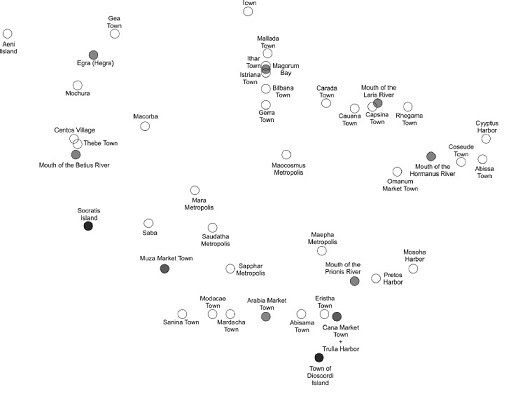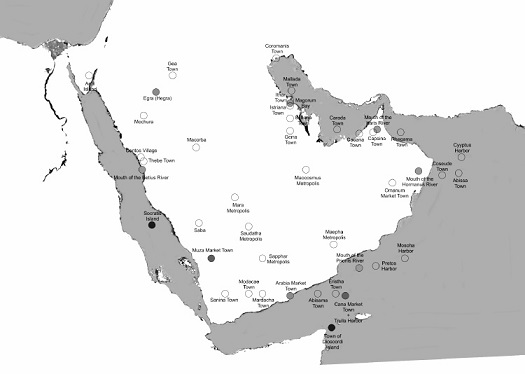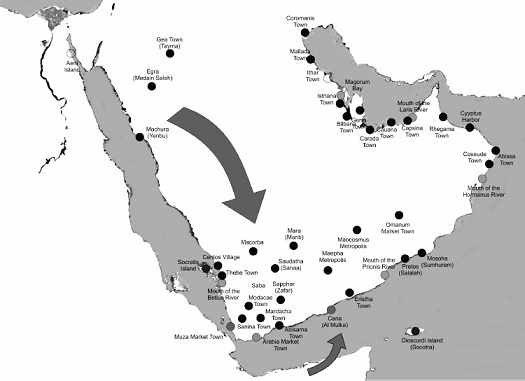http://www.historyofmecca.com/historical_claims.htm#macorabaWas Macoraba Mecca?
A purely speculative and as becomes increasingly obvious false, presumption, that is clung to in great desperation - as if it could take the place of 4500 year's worth of historical and archaeological evidence of a pre-4th century Mecca - is suggestion that Ptolemy's "Macoraba" was Mecca, even through alleged similarity between the two words (perhaps because they both begin with an "m"?). However it is important to note that available evidence suggests the
Arabic language did not even exist until into the Christian era, so similarity between words used by a 2nd century writer - let alone similarity with
ancient Hebrew words like "Baca" for that matter - is obviously coincidental.
Yet in spite of the fact that nobody can deny that such wishful hopes are not evidentiary, we find an endless procession of those that try to rename Mecca, as if it were synonymous or interchangeable with "Macoraba" and even "Baca". Once again, the antiquated 18th to early 20th century dictionaries and encyclopedias are parroted without end, even by modern day encyclopedias! When it comes to events that took place during the 18th to early 20th centuries, or even a century or two before the period the author was contemporary to, the information they pass along may well be reliable and historical. Indeed that is how historical record is developed. But when it comes to an 18th to early 20th century author passing along fables from unhistorical sources, regarding things that were supposed to have taken place thousands of years before them, they were obviously even more information-challenged than today's parrots that regurgitate the same.
For a 21st century information age presentation of Ptolemy's work, as opposed to parroted Islamic so-called "tradition" and dissimulation from obsolete sources, we urge you to visit this link to a paper titled
Suggested Solutions for Issues Concerning The Location of Mecca in Ptolemy’s Geography by Dan Gibson (2013) at academia.edu, for a well reasoned, computer enhanced, locating of Ptolemy's coordinates as adjusted to a modern map (if short on time please scroll to the summary on pages 11 to 14 at that link). To quote a few snippets:
"Over time the names of cities and villages change and ruins crumble and disappear, but river courses, while they may change slightly, are long lasting. Even though water may not flow year round, or perhaps even at all, the existence of the ancient river courses help provide us with several solid coordinates that we can use to bridge between Ptolemy and the globe as we know it today."
"There are a number of city locations on Ptolemy’s map which are well known today. He correctly identifies the Yemeni ports of Muza, Aden (Emporiu Arabia), and Cane.
This provides us with four rivers and three coastal cities that we can identify today."
"We then decided to place Ptolemy’s coordinates on a grid without any reference to any maps. Then we would try and match the rivers to see what Ptolemy had done."

"When we attempted to overlay these coordinates on a modern map many problems arose when trying to fit them correctly. (See below)"

"
The solution to this was to manipulate Ptolemy’s coordinates until the rivers lined up. In order to do this we left two places on Ptolemy’s map in the north. Egra (Hegra), known as Mada’in Saleh today, and Gea Town which aligned with ancient Tayma. We then grouped the Beitius River and the other locations near to it and move them all southward until the Betius River was over Wadi Mawr. (The other grouped locations also moved southward).
When we did this, many of the interior locations suddenly became apparent. In short, we matched Ptolemy’s Rivers to the location of the rivers today to obtain a correct map of Arabia. In doing so it became apparent that Ptolemy was not aware of the vastness of the deserts in Arabia’s interior, and that he plotted the locations in Yemen too far north.
Once we had shrunk Ptolemy’s map southward (with a small twist on the bottom to correct Ptolemy’s angle) many of the locations on Ptolemy’s map suddenly fit. Ptolomey’s Centros Village became modern day Jazan, Tebe Town became AlLuhayyah and Macorba becames Al-Mahabishah. Mara was then positioned as Ma’rib and Saudatha became modern day Sana’a. Sapphar then fit over Zafar, and Mochura in the north became Yenbu. On the Indian Ocean coast Petros became modern day Salalah and Mosoha is what we know today as ancient Sumhuram."

If these excerpts interested you,
please click on this link for additional information on the historical context, methodology and formulas used, aerial photos of the riverbeds and much more.